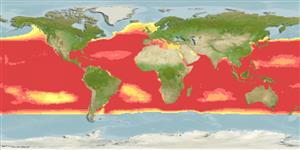Classification / Names
Common names from other countries
Main reference
Size / Weight / Age
Max length : 110 cm FL male/unsexed; (Ref. 89423); common length : 80.0 cm FL male/unsexed; (Ref. 168); max. published weight: 34.5 kg (Ref. 168); max. reported age: 12 years (Ref. 168)
Length at first maturity
Lm 40.0, range 40 - 45 cm
Environment
Marine; pelagic-oceanic; oceanodromous; depth range 0 - 260 m (Ref. 9340), usually 0 - ? m (Ref. 55287)
Climate / Range
Tropical; 15°C - 30°C (Ref. 168), preferred 27°C (Ref. 107945); 63°N - 47°S, 180°W - 180°E
Distribution
Cosmopolitan in tropical and warm-temperate waters. Not found in the Black Sea. Highly migratory species, Annex I of the 1982 Convention on the Law of the Sea (Ref. 26139).
Countries | FAO areas | Ecosystems | Occurrences | Introductions
Short description
Dorsal
spines
(total): 14 - 16;
Dorsal
soft rays
(total): 14-15;
Anal
spines: 0;
Anal
soft rays: 14 - 15;
Vertebrae: 41. Interpelvic process small and bifid. Body without scales except for the corselet and the lateral line. Swim bladder absent. The back is dark purplish blue, lower sides and belly silvery, with 4 to six very conspicuous longitudinal dark bands which in live specimens may appear as continuous lines of dark blotches.
IUCN Red List Status (Ref. 115185)
Threat to humans
Reports of ciguatera poisoning (Ref. 4690)
Human uses
Fisheries: highly commercial; gamefish: yes
Tools
Special reports
Download XML
Internet sources
Estimates of some properties based on models
Phylogenetic diversity index
PD50 = 1.0000 many relatives (e.g. carps) 0.5 - 2.0 few relatives (e.g. lungfishes)
Trophic Level
4.4 ±0.5 se; Based on diet studies.
Resilience
Medium, minimum population doubling time 1.4 - 4.4 years (K=0.3-0.5; tm=2-3; tmax=12; Fec=80,000)
Vulnerability
Moderate vulnerability (40 of 100)
Price category
